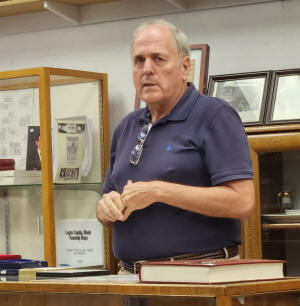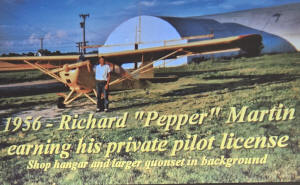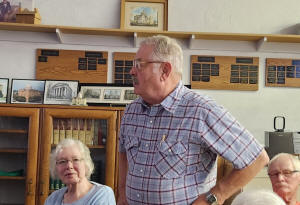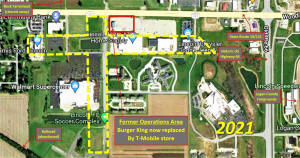|
Former Lincolnite John Fuller
shares knowledge of Lincoln's Bock Airport
 Send a link to a friend
Send a link to a friend
[September 19, 2023]

On Thursday, September 14, a special Logan County
Genealogical and Historical Society meeting was held with former
Lincolnite John Fuller sharing a video he made and some information
about the old Bock Airport on the west side of Lincoln.
The Bock Airport was located on Route 10 in an area which is now the
location of the Walmart Supercenter.

LCGHS members Richard and Mary Ellen Martin both
remember when the airport was out there. Richard Martin got his
pilot's license out at the Bock/Lincoln Airport in 1956. Mary Ellen
Martin got her pilot's license at the Logan County in 1972.
Other members recall planes flying in that area.
Some of the pilots Fuller and others recall flying at the Bock
Airport were Jimmy Malerich, Lindy Fancher, Chuck Bennis, Benny
White and Bob Donath.

LCGHS president Bill Donath said Bob Donath used to
refurbish planes. Now his son does the same kind of work in Chicago.
Fuller is looking for photos and memorabilia of the Bock Airport. He
barely remembers when planes flew there.
Last year, Fuller created an almost eleven-minute video sharing some
of the history of the Bock Airport.
When Fuller decided to make the video, he first contacted Gary
Freese and Freese told him about a newsletter article Nancy Gelbach
wrote back in 2000 on the history of aviation in Logan County.
One thing Gelbach’s article talked about Bock/Lincoln Airport on the
west side of Lincoln. Fuller said Gelbach's information about the
first commercial Airport in Lincoln inspired him to make the video.
Fuller also found a website about abandoned airfields that provided
some of the information.

The video shows maps from a few different years with
the Henry Bock/Lincoln Airport layout. The Henry Bock/Lincoln
Airport was used from around 1945 to 1960.

Since Logan County Airport was built in the 1950s
Fuller said Lincoln had two airports for a several years, which was
unusual for a town of about 15,000 people. He said towns of that
size usually did not even have one airport.
At some point, Fuller said there may have been an airstrip near the
fairgrounds, but he has never been able to verify that information.
Around 1945, a pilot landed on Bock’s farmland looking for a place
to train pilots. The pilot, apparently a flight instructor, was
looking for a field where he could give flying lessons, probably
under the new GI Bill program.
Plans emerged to set aside some of Bock's land on the south side of
the road for this new flight school. In the next few years, it
quickly grew into a base for local private airplanes.

Gelbach's article said pilot Lindy Fancher recalls
there being so many people in the Airport office, they could hardly
turn around.
The main activities at Bock/Lincoln Airport were GI Bill flight
training, aircraft sales and repairs and fuel sales.
One of the flight instructors there over the years was Ray Suiter.
Bock/Lincoln airport had a 2000-foot runway as the layouts on old
maps show. There were two perpendicular runways. One crossed the
west runway twice. Fuller said the north/south runway was rarely
used.
1946 was when Fuller said the citizens of Logan County passed a
referendum to plan and fund a new airport. He said construction of
the Logan County Airport began in 1948 and began operating in 1950.
A photo from 1947 or 1948 shows a hangar, office and tie-down area
at the Bock/Lincoln Airport.
The Bock/Lincoln Airport had a 3100-foot runway around 1951. Fuller
said in less than ten years, as aviation activity shifted to the
Logan County Airport, with its hard-surface & lighted runway, the
Bock Airport faded out of existence. It appears the last flyouts
occurred around 1960.

There were a few buildings left at the location of
the Bock/Lincoln Airport. Fuller said these buildings were leased to
other businesses for auto repair and equipment storage.
In 1963, Fuller said a tornado destroyed many of the remaining
structures at the former Bock Airport location. A photo in the video
shows the damage from the tornado months later.
Hangars still remained in that location in 1977. Fuller said some of
the buildings were still out there as of 1986.
The Bock Airport office was located on the site where Burger King
was later built. The building there is now a T-Mobile store.
Local pilots share their memories

Local pilot Larry Whitbeck shared some stories of
being a pilot. He was presumably the last pilot to fly to where Bock
Airport had been.
While growing up in Nebraska, Whitbeck said he was
flying with a local crop duster by age 13. In the 1960s, Whitbeck
remembers an International Soaring Contest near McCook Base. Soaring
enthusiasts from around the world came to the contest.
The runways at McCook Base were 6000 feet. Whitbeck said a couple
airports in Nebraska have been turned into feed lots for livestock.

When Whitbeck became interested in the history of
military runways, he said he flew to all five of the old military
runways in Nebraska.
After he moved to Lincoln in 1972, Whitbeck recalls seeing what
looked like a scrap iron pile on the old Bock Airport property.
Whitbeck said he felt called to fly in to runway 18.
On a website about abandoned and little known airports, Whitbeck’s
story is shared. Whitbeck said, “The plane I landed there was my
first personal airplane - a forest green & Daytona Cream Stinson
108-1! I purchased that airplane in the summer of 1973."
Whitbeck said, “I landed on the south end of Runway
18 because I knew the airport had been closed for years, and I did
not want to get in trouble by someone reading my N-number had I been
on Runway 27. That [Stinson] had a very short takeoff roll with only
the pilot on board, maybe 500-600'. All took place south of the
field waterway, which was soft & grown up with taller grass.”
The only building Whitbeck said was left at that time was the
Quonset [hut] with old junk & farm machinery stored in it, none of
which looked usable.
Years ago, when Whitbeck became a pilot, he used to hunt coyotes out
of airplanes. He said it was legal and there was a five-dollar
bounty on the coyotes. Whitbeck had always landed on grass runways.
[to top of second column] |


In the area where Farm and Home Supply now sits,
Whitbeck said there used to be a waterway. He thinks concrete was
put over where the waterway was with little to support the concrete
under the parking lot.
When Whitbeck landed beyond the waterway by the old airport, he said
he was off the ground with plenty of runway left as he landed on the
south end of runway 18. He then turned around and went back. The
waterway crossed runway 27 twice and Whitbeck said that runway was
too short for him to use.
For many years, Whitbeck never said anything to anyone about flying
to the location of the old Bock Airport.
Whitbeck's story of landing on the old Bock Airport runway can be
found on the Abandoned and Little-Known airfields website. Fuller
said the information about Bock Airport is found in the link to the
Northern Illinois section.

Old photos on the website show airplanes sitting at
Bock Airport. Fuller said the hangars can be seen in old photos too.
Richard Martin remembers a time when there were many planes in the
hangars at Bock/Lincoln Airport. Martin said the office there was
not very big at all.
One memory LCGHS President Bill Donath has of the Bock/Lincoln
Airport is helping clean a bird’s nest out of a T-hangar there so
the birds did not build nest in the engines. Donath said his “pay”
was an airplane ride.
Fuller asked Richard Martin to share a story of a crash where Martin
was a passenger. Martin said he was the passenger in a two seat
Globe Swift 125 when they went up on the nose of the airplane during
a failed southbound takeoff at a low spot on a rainy day.
At some point, Martin warned the pilot about the water in the
intersection from a thunderstorm earlier in the day.
The pilot had a new prop and wanted Martin to go up with him. The
pilot said they would not reach the area where there was too much
water. Martin said the airplane was sitting right on its nose. The
airplane’s new propellor broke into pieces.
Though Martin said no one was hurt, when the pilot stepped on the
wet grass, the pilot busted his chin open of the airplane's tail.
Martin heard the pilot say a few choice words.

The pilot and Martin then pushed the airplane back to
the hangar. Martin said the airplane needed a new propellor.
On older planes, Whitbeck said propellors had manual hydraulic
spring-loaded hubs with wooden blades. The blades would adjust by
RPM. Whitbeck said they were shiny black, looked nice and worked
really well.
Stinson planes were ones Whitbeck said were popular. Whitbeck
remembers flying in a Stinson with a friend and wanting to have his
own Stinson someday.
When Whitbeck got enough money together, he went to Mexico, Missouri
and bought a Stinson airplane for $3800. He did a lot of work on the
Stinson when he owned it. Whitbeck had the plane two years, flew it
111 hours and sold it for $8000. He said the airplane is still being
used by a pilot in Canada who has it on floats and skis.
Something Martin remembers about flying at Bock/Lincoln Airport is
not having any runway lights. The pilots used smudge pots filled
with kerosene and put them out at the edges of the runway to give
off some light. Martin said they always used the East/West runway.
One night around harvest time, Martin said Cecil Steinauer came in
with an air coop, which has low wings. Martin said Steinauer got a
little bit too low with the plane and the corn drug him down. The
ears of corn broke the windshield and Martin said the airplane cabin
was full of corn.
One of the things Whitbeck recalls that well-known pilot Charles
Lindbergh would tell stories about lanterns being lit to help him
see to land his plane. Whitbeck himself has landed on gravel runways
in Alaska with no lights.
The first airfield Lincoln had was by Kruger Elevator just southeast
of Coonhound Johnny’s Roadhouse. The Cresco plant is now there.
Fuller said one pilot had a fatal crash on the railroad tracks by
the elevator.
An area near where Lincoln Community High School now sits is where
Fuller said [former] local businessman Marv Boss Jr. learned to fly.
Martin said John Charter had an airstrip out that way in the Home
Avenue area. Fuller said Charter’s house was designed with a garage
he could park his airplane in.

Another story Fuller shared was about Charles
Lindbergh landing at Bosa Field, the first airport in Sangamon
County [around Springfield] in his Spirit of St. Louis plane. Fuller
said it was soon after Lindbergh returned from Paris.
There was memorabilia of Lindbergh’s flight Whitbeck remembers
seeing at Springfield Airport in the 1970s.
In Lindbergh’s book about the Spirit of St. Louis, Fuller said
Lindbergh shared stories of night flights. Around half a dozen
lanterns would be placed on the fence by the truck driver for the
post office.

One night, Lindbergh took off from Peoria. Fuller
said Lindbergh could not get into Peoria, so Lindbergh turned around
and he was able to land in a field lit by two or three lanterns.
The reason Whitbeck said a runway is not depicted in some photos is
that pilot would just land into the wind where there was enough
ground. Pilots would land anyplace in that marked area rather than
on a designated runway. Whitbeck said the earliest airports would
have a mile square and pilots always took off into the wind. There
was never a marked runway in those early airports.
One story Fuller recalled was about Lindbergh bailing out near
Bloomington in a parachute. Lindbergh went into a general store and
asked people to help find his plane. The plane was full of mail
bags, so Lindbergh gave the men a pistol to guard the mail until he
could get back.
Fuller said Lindbergh then rode the train to Chicago and got another
airplane. When Lindbergh flew back, he landed near where his other
plane was and got the mail bags.
Lindbergh’s last bale out in Illinois was in November 1927. Fuller
said Lindbergh was already promoting the idea to St. Louis bankers
and financiers about flying non-stop to Paris. Lindbergh would get a
prize for $25,000 if he flew non-stop.

The Spirit of St. Louis was designed and built in
1927. Fuller said they built the plane in about 60 days.
The reason Whitbeck said they were able to build the Spirit of St.
Louis so quickly is that the wings and tail for that plane came off
a monoplane they were already building. The fuselage was then
modified.
Jimmy Stewart’s movie The Spirit of St. Louis is one of the things
Fuller said got him hooked on flying. After reading Lindbergh’s book
and comparing the movie to it, Fuller found the movie was very
accurate.
The last story Richard Martin shared was about Lloyd Caldwell, who
had worked for Henry Bock and helped build the new airport. Martin
said Caldwell’s nickname was “Looper. The nickname came about
because when Caldwell was supposed to put one of the planes in the
T-hangars, Martin said Caldwell would take off on a taxiway, do a
loop and then put the plane away.
The planes Caldwell flew back then were Jenny planes. Martin said
Caldwell would brag about the time he flew from Mt. Pulaski to
Lincoln and had three emergency landings. Martin said Caldwell was
quite a guy.
Fuller remembers his first airplane ride being in the back seat of
Jim Malerich’s plane. Fuller said he was afraid and grabbed a
railing behind him. Fuller did not realize it had a sliding canopy
and it closed on his fingers.
The presentation Fuller gave will be on a video Bill Donath will
post on the LCGHS YouTube channel. Donath will also post a link to
Fuller’s video and to the website about Abandoned and Little-Known
Airfields.
Related link:
Abandoned and Little-Known Airfields
http://www.airfields-freeman.com/IL/Airfields_IL_N.htm
[Angela Reiners]
 |